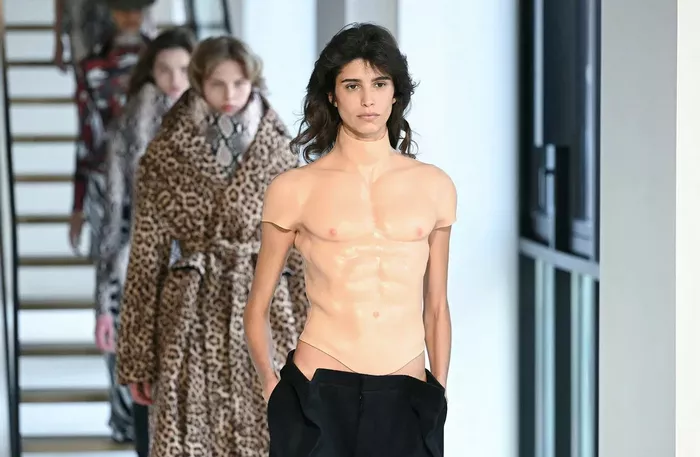Dutch designer Duran Lantink made a striking impact during his Fall-Winter 2025 show at Paris Fashion Week, unveiling a collection that defied conventional aesthetics. Set against an office-like backdrop reminiscent of the science fiction thriller Severance, his designs featured distorted proportions, eccentric animal prints, and provocative butt-revealing jeans. However, it was the use of prosthetic torsos that captured the most attention. Model Mica Argañaraz displayed a sculpted six-pack, while Chandler Frye, an emerging male model, stunned the audience with a set of oversized, bouncing breasts.
Lantink’s bold presentation quickly went viral, igniting debates on social media about whether it was an endorsement of gender fluidity or a mockery of femininity. For the designer, the intention was to challenge perceptions by playing with the concept of humans as dolls. He expressed his admiration for the idea of women as action figures in his show notes. While his vision was unique, it also reflected a larger trend in contemporary fashion: the growing incorporation of prosthetics.
In recent seasons, leading fashion brands such as Martine Rose, Collina Strada, and Balenciaga have explored the use of prosthetics, masks, and 3D makeup techniques to craft otherworldly appearances. Avavav, a Stockholm-based label renowned for its avant-garde latex creations, previously made headlines by designing a wearable silicone replica of Kim Kardashian’s backside. These artistic explorations reflect an evolving approach in fashion where prosthetics are employed to challenge beauty standards and redefine identity.
The use of prosthetics in human culture dates back to ancient Egypt, where artificial toes were used as walking aids. Around 300 BC, the first known prosthetic leg, crafted from bronze and wood, was introduced for a Roman nobleman. The 19th century saw advancements in prosthetic technology following the American Civil War, leading to the development of wooden limbs with rubber cushioning. Beyond their medical applications, prosthetics found a role in the entertainment industry. The late 19th and early 20th centuries saw crude prosthetic materials like gum, cotton, and wax being used in early cinema. By the 1930s, foam latex revolutionized the industry, making rubber masks widely accessible. Over time, prosthetics also became a fundamental part of the art of drag, helping performers achieve exaggerated femininity through breastplates and hip pads.
Modern prosthetic applications in film and entertainment have reached new heights. The 2024 horror film The Substance earned an Oscar for its use of prosthetics, though lead actress Margaret Qualley later revealed the effects caused skin damage that took a year to heal. Prosthetics have also become integral to red carpet fashion. Special effects makeup artist Malina Stearns, known for her work on Doja Cat’s 2023 Met Gala feline-inspired look, has crafted prosthetics for various artists, including Sabrina Carpenter and Doechii. She has frequently utilized fake body modifications to blur gender norms, noting that she has applied artificial breasts to men and vice versa.
Fashion has increasingly borrowed from the world of entertainment, with designers leveraging prosthetics to create dramatic runway spectacles. Balenciaga collaborated with makeup artist Inge Grognard in 2019 to give models exaggerated cheekbones and pouts. Photographer and visual artist Nadia Lee Cohen used prosthetics, wigs, and costumes to transform into 33 different personas for her 2022 project HELLO My Name Is. Drag queen Alexis Stone has become renowned for attending Paris Fashion Week in elaborate celebrity disguises, meticulously transforming into figures such as Adele after weeks of research and preparation.
Makeup artist and entrepreneur Isamaya Ffrench has consistently pushed the boundaries of prosthetic artistry in fashion. Her work has included elfin-eared models for Burberry, extraterrestrial designs for Paco Rabanne, and animalistic transformations for Collina Strada. Designer Hillary Taymour, the founder of Collina Strada, emphasized that prosthetics allow designers to break down artificial barriers between humanity and nature, making them an integral part of fashion storytelling. Her team sourced prosthetics from a prop studio, meticulously painting and modifying them to create an organic yet surreal effect.
Beyond aesthetics, prosthetics in fashion have served as a social commentary on the normalization of body modifications. Martine Rose made a statement at Milan Fashion Week by sending models down the runway with fake noses, challenging Eurocentric beauty standards. She pointed out that the nose is often the first feature people alter about themselves. While cosmetic procedures are typically undertaken for subtle enhancement, fashion prosthetics are designed to be noticeable, creating eye-catching moments that drive digital engagement and social media virality.
Taymour sees prosthetics as a powerful tool for artistic expression, allowing designers to reshape the human form in ways that extend beyond clothing. Mollie Gibb, a lecturer specializing in hair, makeup, and prosthetics, echoed this sentiment, emphasizing how prosthetics enhance fashion’s narrative potential by aligning makeup artistry with a collection’s thematic statement.
Some designers have used prosthetics for both artistic and functional purposes. Alexander McQueen’s Spring-Summer 1999 show featured a Paralympic athlete with intricately carved prosthetic legs, highlighting the intersection of disability and high fashion. More recently, emerging designer Zhongzhi Ding introduced jeans with a built-in sponge penis, inspired by the homoerotic art of Tom of Finland and designed for transgender men seeking gender-affirming clothing. Ding suggested that as body image anxieties grow, demand for prosthetics addressing various body parts may increase in the future.
For the moment, prosthetics in fashion remain primarily a tool for fantasy rather than function. However, there is potential for them to evolve beyond their current limitations. Taymour envisions a future where prosthetics are integrated into full-body transformations with dynamic movement, incorporating animatronics or soft robotics to create living, breathing fashion. With fashion continuously pushing boundaries, the intersection of prosthetics and high fashion is poised to expand even further, redefining the way identity, transformation, and artistic expression are explored on the runway.
Related Topics
- How TikTok and Instagram Are Shaping the Future of Makeup for Photo and Video Shoots
- Shein’s Participation in Vancouver Fashion Week Sparks Backlash
- Rakul Preet Singh Stuns in a Strapless Bodycon Outfit at Lakme Fashion Week 2025

